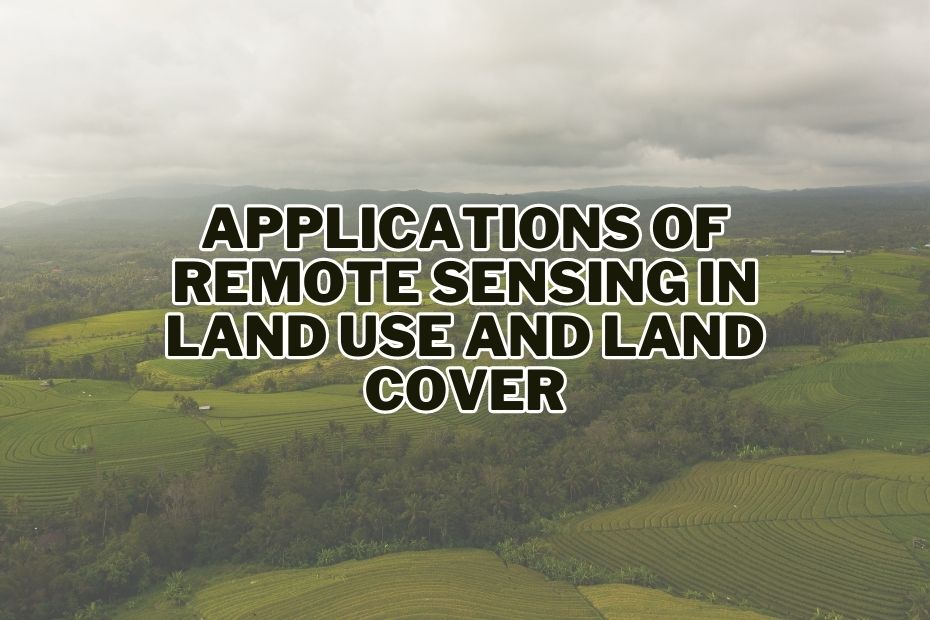Remote sensing, a revolutionary technology, has emerged as a powerful tool in analyzing and understanding the dynamic patterns of land use and land cover. By harnessing data acquired from satellites and other aerial devices, experts have unlocked numerous applications across different sectors. In this article, we’ll delve into the diverse application of remote sensing in land use and land cover, highlighting its pivotal role in shaping our environment and driving innovation.
Remote sensing plays a pivotal role in infrastructure monitoring. By leveraging satellite and aerial imagery, it enables efficient tracking of structures, detecting changes, and assessing structural health. This technology enhances preventive maintenance, minimizes risks, and aids in timely decision-making for optimal infrastructure management.
Application of Remote Sensing In Land Use and Land Cover
Remote sensing involves collecting data from a distance using sensors and instruments aboard aircraft or satellites. It provides valuable insights into changes on Earth’s surface, making it an essential tool for land use and land cover analysis.
1. Urban Planning and Development
Remote sensing revolutionizes urban planning by providing valuable data on city growth, infrastructure expansion, and spatial changes. This information helps urban planners make informed decisions about resource allocation, transportation networks, and green spaces. By analyzing satellite images, authorities can create more livable and sustainable urban environments, accommodating the needs of growing populations.
2. Agriculture and Crop Monitoring
Precision agriculture relies on remote sensing to optimize crop management and enhance productivity. Through remote sensing technologies, farmers can monitor crop health, detect pest infestations, and assess soil conditions. This real-time information enables precision application of fertilizers, pesticides, and irrigation, resulting in improved yields, reduced costs, and minimized environmental impact.
3. Forestry Management
Forests are essential ecosystems, and remote sensing aids in their sustainable management. It assists in monitoring forest cover, identifying deforestation hotspots, and evaluating the impact of natural disturbances. By understanding forest dynamics, resource managers can implement effective conservation strategies and promote responsible logging practices.
4. Environmental Conservation
Remote sensing contributes significantly to environmental conservation efforts by monitoring changes in ecosystems and biodiversity. It helps detect habitat degradation, invasive species, and changes in land cover. Conservationists use this data to formulate strategies for habitat restoration, wildlife protection, and sustainable land use, ensuring a harmonious coexistence between nature and human activities.
5. Natural Disaster Management
When disasters strike, rapid response is critical. Remote sensing plays a pivotal role in disaster management by providing real-time data during events like hurricanes, earthquakes, and wildfires. By assessing the extent of damages and identifying affected areas, authorities can allocate resources effectively, plan evacuations, and coordinate relief operations, ultimately saving lives and reducing economic losses.
6. Water Resource Management
Efficient water resource management depends on accurate data on water bodies. Remote sensing technology enables monitoring of water quality, sediment accumulation, and changes in water levels. By analyzing satellite images and sensor data, water resource managers can make informed decisions about allocation, conservation, and pollution control.
7. Land Use Change Detection
Understanding changes in land use patterns is essential for effective land management. Remote sensing helps detect alterations in land cover, such as urban expansion, agricultural conversion, and deforestation. By comparing historical and current images, researchers and policymakers gain insights into the driving forces behind these changes and can devise strategies to address associated challenges.
8. Geological and Geomorphological Studies
Geologists and earth scientists rely on remote sensing to study landforms and geological processes. Satellite images and aerial data provide insights into fault lines, volcanic activities, and erosion patterns. This information is crucial for assessing geological hazards, understanding geological evolution, and ensuring safe infrastructure development.
9. Archaeological Investigations
Unearthing the mysteries of the past often involves studying hidden archaeological sites. Remote sensing aids archaeologists by identifying buried structures, ancient settlements, and cultural artifacts. Aerial imagery and LiDAR technology allow researchers to uncover historical landscapes and gain new perspectives on human history.
10. Coastal Zone Management
Coastal areas are susceptible to erosion and rising sea levels. Remote sensing plays a crucial role in monitoring coastal changes, assessing erosion rates, and predicting storm impacts. By analyzing shoreline shifts and beach erosion, coastal managers can develop strategies to protect infrastructure, preserve habitats, and ensure the resilience of coastal communities.
11. Infrastructure Monitoring
The condition of critical infrastructure, such as roads, bridges, and pipelines, affects society’s functionality. Remote sensing technology enables the regular inspection of these structures, detecting signs of wear, damage, and deterioration. By identifying issues early, authorities can prioritize maintenance, allocate resources efficiently, and ensure public safety.
12. Climate Change Analysis
Remote sensing contributes to climate change analysis by tracking environmental shifts over time. It monitors indicators like temperature changes, glacial retreat, and vegetation shifts. By understanding these changes, scientists can assess the impact of climate change on land use and land cover, aiding in the formulation of adaptive strategies.
Conclusion:
Remote sensing’s transformative impact on land use and land cover cannot be understated. From shaping urban landscapes to aiding disaster response, the applications are extensive and diverse. As technology continues to evolve, we can expect even more innovative uses for remote sensing, driving progress across numerous industries.
References:
FAQs: Application of Remote Sensing In Land Use and Land Cover
Can remote sensing detect underground features?
While remote sensing primarily focuses on surface-level data, some technologies like Ground-Penetrating Radar (GPR) can provide insights into subsurface features such as buried structures or archaeological sites.
How accurate are the insights derived from remote sensing?
The accuracy of remote sensing data depends on factors like sensor resolution, atmospheric conditions, and data processing techniques. Advancements in technology have significantly improved accuracy over the years.
How does remote sensing contribute to archaeology?
Remote sensing helps archaeologists identify potential archaeological sites by analyzing land cover patterns that may indicate buried structures or historical features.
Can remote sensing detect archaeological sites?
Yes, remote sensing can identify hidden archaeological sites through the analysis of surface anomalies.
